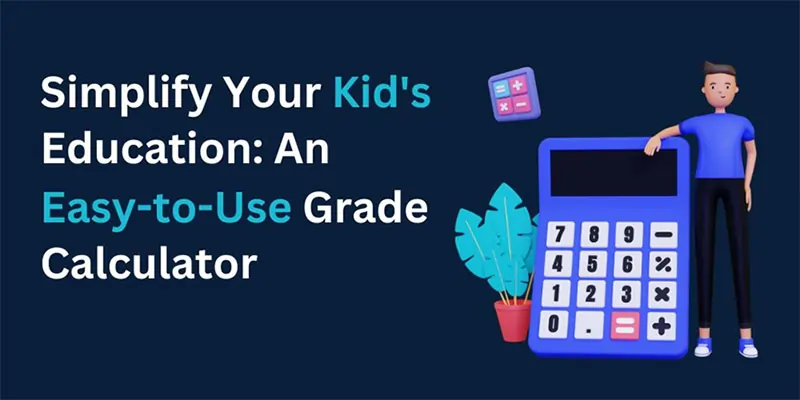Simplify Your Kid’s Education: An Easy-to-Use Grade Calculator

Balancing your child’s education can be challenging. Between complex grading systems, weighted categories, and inconsistencies between teachers, calculating your kid’s grades can quickly become frustrating and time-consuming. A quality grade calculator can simplify managing your child’s grades. Read on to learn more about choosing and utilizing an easy-to-use grade calculator to gain insights into your kid’s education.
Introduction
As a parent, you want to be engaged and informed when it comes to your child’s education. Monitoring your kid’s grades enables you to identify areas of strength to encourage, as well as weaknesses to address. However, the wide variety of grading systems and calculations used today can make deciphering your child’s grades seem like solving algebra word problems again! A user-friendly grade calculator levels the playing field.
Understanding Grading Systems
School districts utilize different grading systems and calculations. Here are a few popular options:
The Traditional 10-Point Scale
This familiar grading system assigns a percentage and letter grade for each assignment. 90-100% is an A, 80-89% a B, 70-79% a C, 60-69% a D, and below 60% an F. The final grade is the weighted average of all assignments.
Standards-Based Grading
Rather than percentage scores, students receive a ranking for meeting standards on each assignment like “Advanced,” “Proficient,” or “Developing.” The final grade reflects the student’s overall mastery of standards.
Mastery-Based Grading
Students demonstrate mastery through projects, oral assessments, or portfolios vs traditional tests. Grades are pass/fail rather than percentage-based.
Challenges with Calculating Grades
Manually determining your child’s grade can be complicated, especially when teachers use inconsistent systems. Common complexities include:
Complex Formulas
Teachers often weight assignment categories like homework or tests differently. This requires multi-step calculations.
Weighting Categories Differently
While one teacher may weigh homework as 10%, another weights it as 30% of the final grade. This inconsistency adds complexity.
Inconsistent Grading Scales
When teachers use different scales like percentages, pass/fail, or standards-based rankings, translating grades becomes very challenging.
Benefits of a Grade Calculator
Using an online grade calculator simplifies managing your kid’s grades. Key benefits include:
Saves Time
Automating complex grade calculations reduces the time spent determining your child’s grade.
Reduces Errors
Eliminating manual calculations lessens the likelihood of errors.
Provides Insights
Charts and graphs offer visibility into your kid’s grade trends.
Key Features of a Good Grade Calculator
When selecting an online grade calculator, look for the following:
Works with Any Grading System
Whether percentages, standards, or rubrics are used, the calculator should flexibly accommodate any grading system.
Adjustable Weights
The ability to mirror each teacher’s weighting of assignments and categories simplifies calculations.
Charts and Graphs
Visual data allows you to quickly discern grade patterns and trends.
Using a Grade Calculator Effectively
Follow these tips to utilize a grade calculator successfully:
Enter Grades Promptly
Input your child’s grades after each assignment to keep calculations up to date.
Update Weights as Needed
If teachers modify their grading policies, update any weighting changes.
Identify Trends
Review charts regularly to identify areas of strength or weakness so you can take action.
Conclusion
Simplifying your involvement in your kid’s education enables you to better support their success. An online grade calculator reduces time spent deciphering complex grades and offers insights through data visualizations. Consider implementing this useful tool to gain clarity into your child’s education and make the grade…with ease.
FAQs
Q: Are grade calculators able to work with non-traditional grading systems?
Yes, quality grade calculators accommodate any grading system, whether standards-based, mastery-based, or traditional percentage grades. Flexibility is key when selecting a calculator.
Q: Can I weight assignment categories differently per teacher in a grade calculator?
Grade calculators allow you to customize assignment category weights per teacher to match their individual grading policies. Adjust these as needed within the calculator.
Q: Do I have to enter grades after every assignment?
While entering grades regularly is ideal, a grade calculator will properly calculate grades regardless of frequency. Just be aware that less frequent grade entries provide less visibility into ongoing progress.
Q: Can I access the grade calculator on my phone?
Many online grade calculator options provide both website and mobile app access for convenience. This allows you to enter grades and view analytics on-the-go.
Q: Is there a way to export the graphs from a grade calculator?
Most grade calculators allow you to export visual grade data to image formats or PDF to share insights on your child’s progress with teachers or your student.



